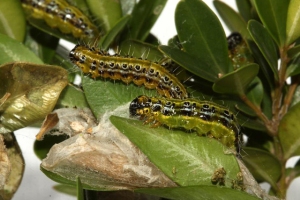Back in 2021, the box tree moth, a new problem for boxwoods, was accidentally shipped from Canada to the United States. This caterpillar pest had been established in Ontario, Canada but over the last couple of years, established populations were found in New York and Michigan here in the U.S. In the 2021 incident, Michigan, Connecticut, and South Carolina received infested materials. At the time, Kentucky seemed to be in the clear regarding this pest. However, this month, a sample of this pest was trapped in the Hamilton County, OH area. This puts it much closer to Kentucky, and that means an increased need to recognize this pest and be on the look-out for it.
What is the box tree moth?
Box tree moth is an invasive species originally from Asia (specifically China, Japan, Korea, and Eastern Russia) and it has been creating extensive damage in over 25 European nations since first appearing in Germany in the mid-2000s.
In its final instar, the box tree moth caterpillar is about a half inch long. It is primarily yellow green in color, with black and white stripes that run vertically down the body on each side (Figure 1). On each abdominal segment there is a pair of black dots.
The adult moth is broadly fan shaped. Most adults will have brown exterior margins on their wings and an inner white triangle that spans the wings and body. Some adults may be completely brown. The box tree moth superficially resembles the melonworm moth in coloration and the patterns on their wings. The box tree moth has white comma-like markings near the wing margins that the melonworm lacks.


Why is it an issue?
This pest will be an issue for the many boxwoods grown in production in Kentucky, as well as the ones already in place as a landscape plant. So far, they have only been observed to feed on boxwood plants in the genus Buxus, other landscape plants should be safe from their hungry mouths.

As for the damage they create, tree moth larvae feed on the leaves and the bark of boxwood plants. The initial caterpillar stages after emerging from their egg will feed on the undersides of leaves, creating a papery or peeling appearance. Older larvae eat entire leaves, leaving behind only the midrib. As the plant runs out of foliage, the larvae will move lower on the shrub to feed on the bark. This will induce girdling and may possibly kill the plant. The older larvae also produce webbed structures (similar to what you see with tent caterpillars and webworms), which are messy, filled with dead leaves and shed skins. In Europe, there has been widespread devastation of boxwoods in infested areas.
What to do now?
For now, nursery owners and those who own boxwoods in their landscape (essentially almost everyone in Kentucky) should monitor their plants for the distinct symptoms created by this pest.
Boxwoods are also hosts to boxwood leafminers and boxwood psyllids that may leave behind damage. Box tree moth is the only caterpillar pest of boxwoods, and their damage is different in comparison to our other pests. Boxwood leafminers cause the leaves to appear blistered as they feed from the inside. There is also an orange or bronzed color caused by their damage, which is focused on the newest growth. Similarly, boxwood psyllid prefers to attack the newest foliage, but they cause the leaves to cup inward on themselves. Winter damage can also superficially resemble the symptoms of box tree moth. None of these issues would include the webbing associated with box tree moth.

If you believe you have encountered this pest or that your plant has been damaged by it, UK Entomologists appreciate you submitting a photo or sample in order to confirm or deny this. Samples can be submitted directly to the Office of the State Entomologist/Department of Entomology by emailing reportapest@uky.edu.
By Jonathan L. Larson, Entomology Extension Specialist
